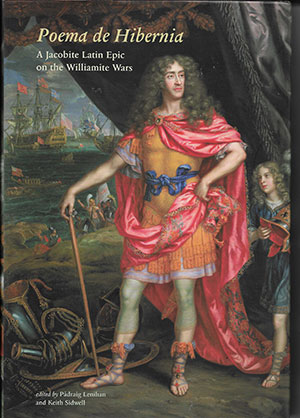Poema de Hibernia: a Jacobite Latin epic on the Williamite Wars
Published in Book Reviews, Book Reviews, Issue 6 (November/December 2018), Reviews, Volume 26PÁDRAIG LENIHAN and KEITH SIDWELL (eds)
Irish Manuscripts Commission
€50
ISBN 9781906856597
Reviewed byThomas Black
 Thomas Black is a doctoral researcher in early modern Scottish and Irish literature at the University of Nottingham.
Thomas Black is a doctoral researcher in early modern Scottish and Irish literature at the University of Nottingham.
The Poema de Hibernia was written in captivity by an unknown Catholic Irish Jacobite immediately after the Williamite conquest of Ireland in 1691. The poem swells with energy, learning, passion, dark humour and tragedy as it recounts in grandiose Latin verse the fall of James II in England and the bloody campaign that followed in Ireland. In size and scope it dwarfs all other Irish literature on the subject in English, Gaelic or Latin. It is surely as remarkable for its content and form as it is for its history as a book; it has lain almost completely unread and unknown since its creation until Pádraig Lenihan and Keith Sidwell’s recovery of the text from the archives of the Dublin City Library. This is a lost epic of Ireland and this, the first published edition, unlocks it for the first time for the modern reader.
Derry and the Boyne, Aughrim and Limerick, Patrick Sarsfield and Séamas an chaca (‘James the shite’)—these are still names to conjure with in Irish history. The charge and import of these events and persons still resonate today, and the Poema lavishes attention and detail on them. In its nearly 6,000 lines of poetry an Irish nation takes shape, as Gaels and Anglo-Normans alike unite under the banner of a common religion and homeland to fight for their monarch. Irish republicans have found the overt royalism of Jacobitism hard to stomach and have often attempted to explain Jacobitism away as an insincere fad of an oppressed Irish people who were simply waiting for something better. More recently scholars have drawn the link between Jacobitism and the formation of a self-conscious Irish Catholic nation, and the growth of nationalism that evolved into republicanism. The author of the Poema fused his royalism with sincere patriotism and uses his work to stake out space for an Irish nation and celebrate his homeland as:
Banba, ancient island, loyal
To its own ancient King, the last of lands,
Placed far apart beneath the western sky,
Where Thetis does receive the setting rays
Of Phoebus in her waves.
The geography, loyalty and religious integrity of the island and its inhabitants are all pillars of a patriotism that would develop into the nationalism of later years.
Patriotism, and even nationalism, did not entail full-blown support for Irish independence—indeed, it rarely has in Irish history until more recently. Using its classical Latin models of Virgil and Lucan, the Poema paints Ireland into the heart of a British civil war, which itself forms a theatre of a larger clash between the titanic forces of France and her adversaries on the Continent. In the eyes of the poet, Ireland is British and European and there is no necessary dichotomy. The struggle against William of Orange is depicted not as a struggle against the British state but against a sickness within that state, and a strong, united, Jacobite Ireland is to be the cure of the whole body politic. By putting these crucial moments of Irish history into epic poetry the poet gives them gravitas and stature. Indeed, in choosing the epic form the poet may have conceived that he was writing a national epic, and certainly he gave structure and weight to the idea of a sovereign Ireland within the British monarchical system. The victory of the Irish nation is, however, painfully deferred in the poem. James retreated to France, and the Jacobite army followed after a series of military disasters. Thus the poem ends with the Catholic Irish nation, crammed into boats, straining to keep Ireland in sight as they sail away, promising to return in victory. This vision of diaspora, with the tantalising promise of return, is the enduring image of the poem and a poignant reminder of those patterns of defeat and exile which would characterise much of Irish history for many years to come.
Latin is obviously no longer the accessible and pan-European intellectual language it once was, and for a modern audience our appreciation of this work rests in no small part on the strengths of the translation. Keith Sidwell’s verse translation has a lot to commend it to the general reader. In English, ten-syllable blank verse has long had the epic and classical weightiness to carry a lengthy poem of this nature, and his decision to employ this rather than attempt a reconstruction in prose is a sound one. Sidwell’s verse, however, is rich in archaic forms and Latinate sentence structure. The attempt to accommodate significant elements of Latin grammar in English poetry has only really been successfully executed by John Milton. The Miltonic flavour, coupled with the semi-eighteenth-century idiom of the translation, can make for occasionally obscure and difficult reading. That being said, producing 6,000 lines of strong poetry that both retains a consistent poetic voice and successfully renders the learning, wit and gravity of the original is an achievement worthy of praise! Furthermore, the massive scholarship of the editors informs the copious notes and apparatus that frame the text and help make it fully intelligible for the 21st century. The emergence of this text from the archives significantly adds to the available sources for Irish history and culture of the period, and in the rebirth of this epic poem a new voice is added to Irish literature.
















